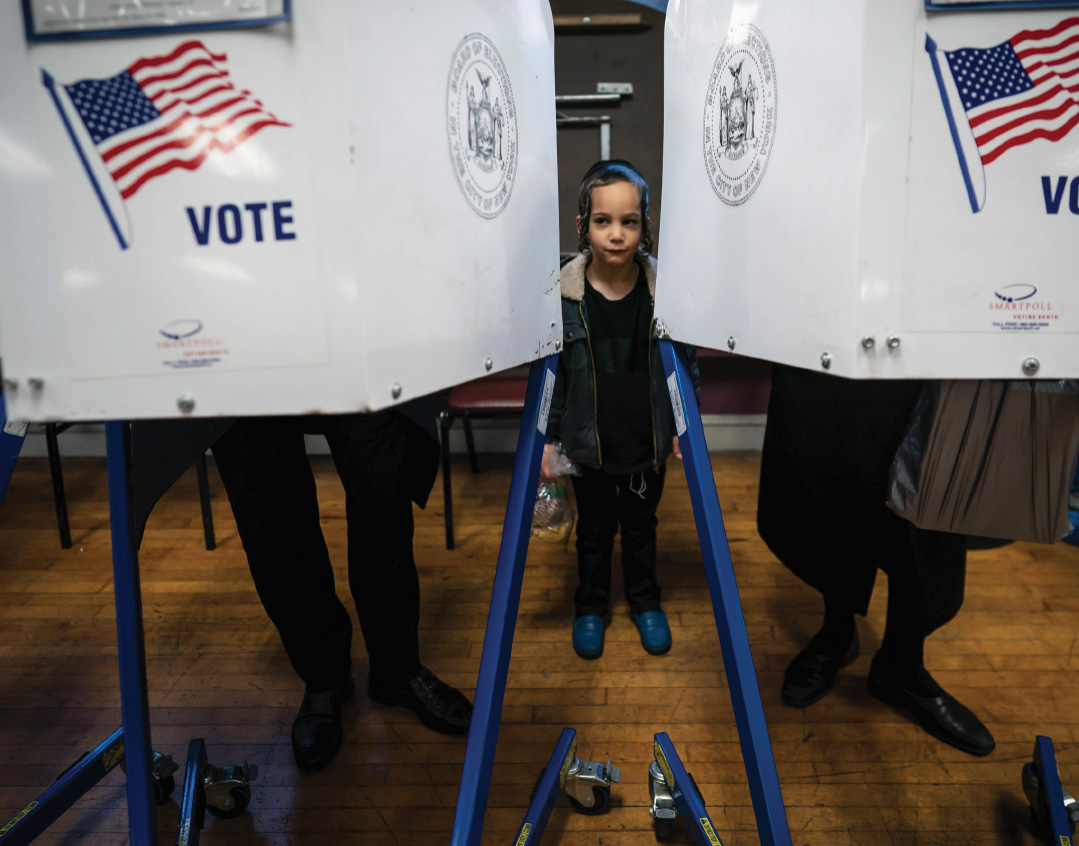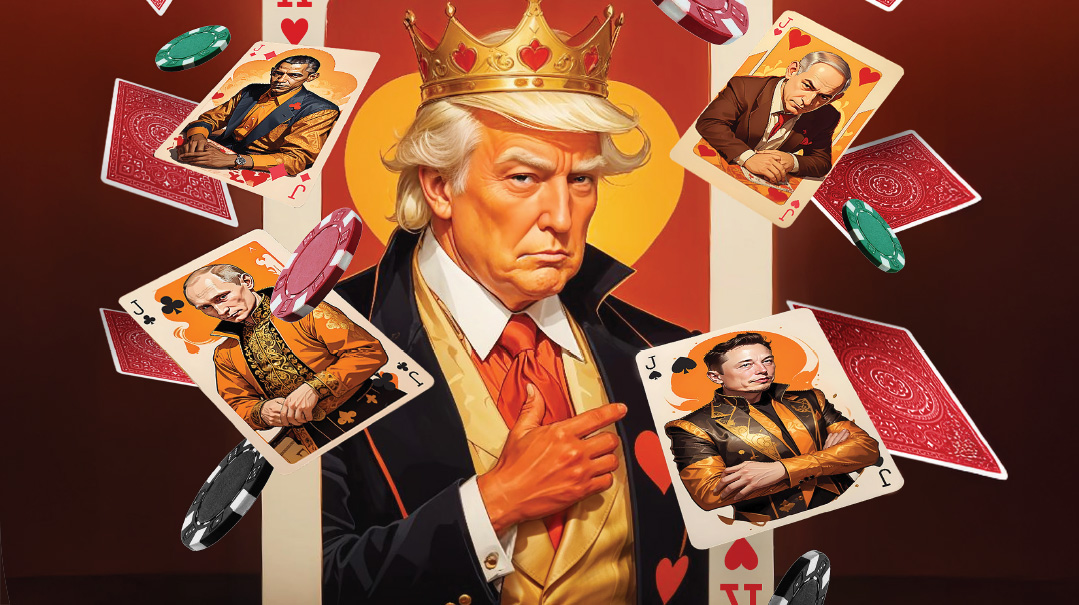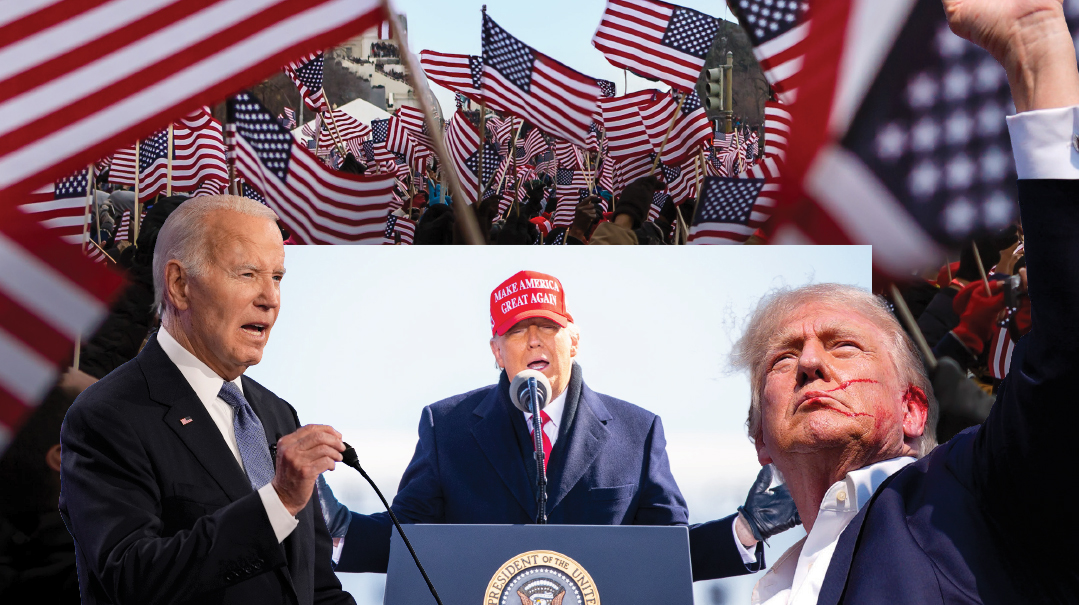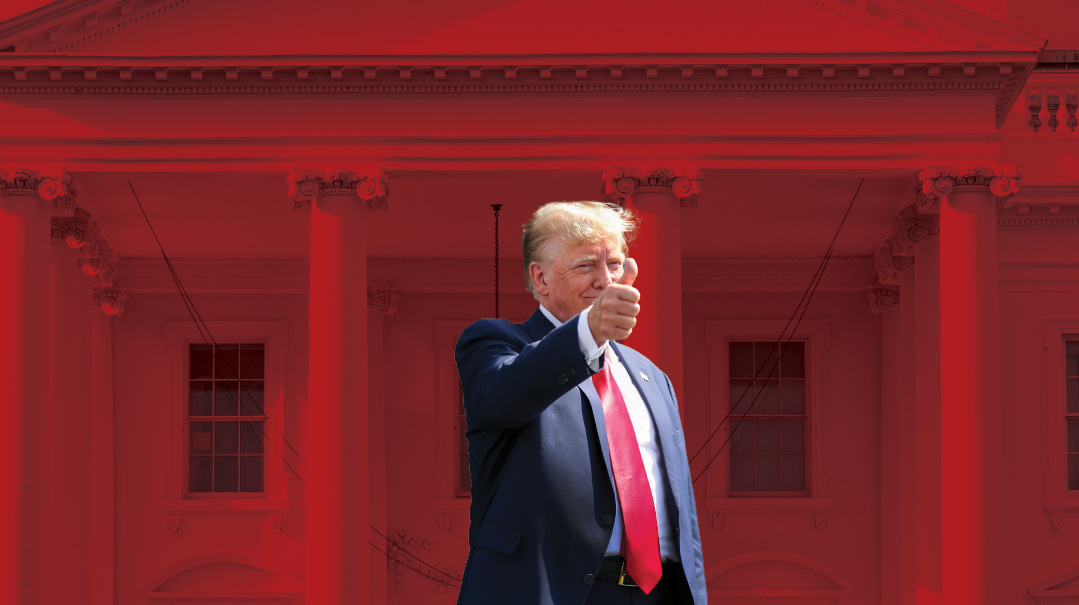Shifting Trends

Through the lens of the Jewish voter, voters of color, and the youth who hold the keys to the future
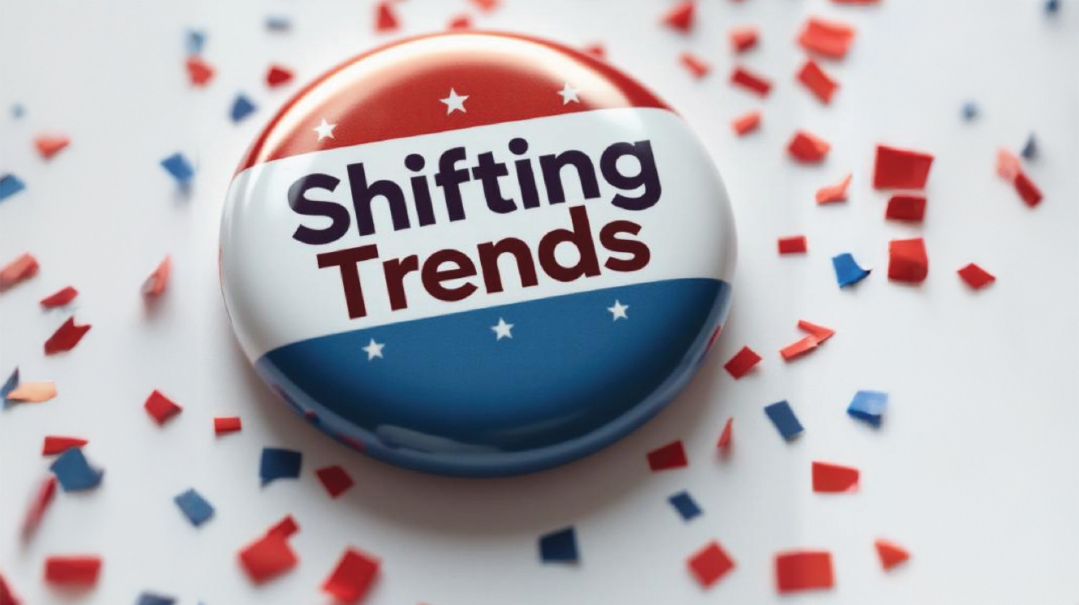
Reputable polls show that America’s registered voters are divided almost equally between Republicans and Democrats. The popular vote results in most presidential races since 2000 confirm that even split.
Normally, this would indicate a healthy balance between the two major parties. Instead, American politics has taken a sickening turn, with supporters of both parties expressing outward hostility to each other, spewing vile and boorish political discourse on mainstream media and social platforms.
In the worst-case scenario, the atmosphere has emboldened armed radicals to use the bullet against a presidential candidate (Donald Trump) and members of Congress (remember Steve Scalise and Gabby Giffords?) while alienated citizens use the ballot to send more extreme representatives to Congress.
How did we get to this state? How did it likely impact this year’s election? Are we headed toward a saner future, or is the worst yet to come? We explore the answers to these and other questions through the lens of the Jewish voter, voters of color, and the youth who hold the keys to the future.
The Jewish Vote
In a nutshell:
Neither party has a monopoly on the Jewish vote. Jews are not single-issue voters. The major parties parted ways on Israel.
More than 100 years ago, Jews voted Republican in greater numbers. In 1916, Charles Evans Hughes won 45% of the Jewish vote in his loss to Woodrow Wilson. Four years later, Warren Harding won a plurality of the Jewish vote — 43% in winning a three-man race between Democrat James Cox and Socialist Eugene Debs, who won 38% of the Jewish vote.
Herbert Weisberg, a professor of political science at Ohio State University, explains that the early 20th-century Jewish voters were mainly middle-class German immigrants, but by the time Debs rolled around, newer Jewish immigrants had arrived from Eastern Europe, were working-class, and found socialism appealing.
After 1928, when Al Smith, the popular Democratic four-term New York governor, ran for president, the Jewish vote switched allegiances. From then on, Democrats began to dominate the Jewish vote by 2:1 and even 3:1 margins with less than a handful of rare exceptions: Dwight Eisenhower won 40% of the Jewish vote in his 1956 reelection bid, and Ronald Reagan captured 39% in 1980 when he beat Jimmy Carter in a landslide.
The Way It Is
Jewish but less Bluish
Donald Trump, who won 30% of the Jewish vote in 2020, may have put his foot in his mouth when he launched a preemptive attack on Jewish voters, saying it would be their fault if he lost, but when you look at the math, he has a point.
Many pundits (myself included) contend that whoever wins Pennsylvania this year wins the election. Pennsylvania has 300,000 Jewish voters. Joe Biden beat Trump in the Keystone State by less than 80,000 votes in 2020, while Trump bested Clinton there by 44,000 in 2016. Florida, with 665,000 Jewish votes, shouldn’t be close this year, but who can forget the 2000 Bush-Gore election, when Bush won the Sunshine State by a mere 537 votes?
The Brandeis National Profile of the Jewish Electorate in 2020 showed that 3.2 million voting-age adults who self-identify as Jews live in just four states: New York, California, Florida, and New Jersey. Some 65% are Democrat or lean Democrat, 28% Republican or lean Republican. About 45% call themselves liberal, 36% moderate, and 19% conservative.
The picture is different for Jews who self-define as chareidi or modern Orthodox.
A Nishma online survey released last month showed that Trump would win 83% of the chareidi and 38% of the modern Orthodox vote, while Harris would win just 7% of the chareidim and 46% of the modern Orthodox.
A mid-October Manhattan Institute poll of Jewish voters showed that Kamala Harris was on track to perform worse in this year’s election than any Democratic presidential candidate since the Reagan era.
The Way It’s Heading
Jewish Red Wave Far from Shore
For decades, conventional wisdom has ordained that US support for Israel must be a bipartisan issue for both Republicans and Democrats. However, support for Israel means different things to different people. The Republican model grants Israel far more leeway to defeat its enemies, while the Democratic formula prefers Israel line up on the defensive side of the line while pining for a two-state solution.
These fault lines have ruptured into a chasm. A late September Economist/YouGov poll asked 1,622 American adult citizens: In the Israeli-Palestinian conflict, are your sympathies more with Israel or the Palestinians? Some 63% of Republicans answered with Israel and only 5% with the Palestinians. Among Democrats, 33% answered the Palestinians, 32% about equal, while only 14% sided more with Israel.
Having said that, American Jewish voters aren’t single-issue voters. Samuel Abrams, a nonresident senior fellow at the American Enterprise Institute, contends that polls show the non-Orthodox community, in particular, is more motivated by cultural concerns and social policy, such as anti-Semitism and physical violence against Jews, and has serious quibbles with Democratic identity politics, including DEI (diversity, equity, inclusion) which rewards race and ethnicity over merit and hard work.
Many people were perplexed that Trump made such a big play for the New York vote, where he trailed Harris by double digits, but he’s looking ahead to a future when the Big Apple turns red at the ballot box and not just on the fruit stands.
Voters of Color
The Way It Was
Republican Progressives and the New Democrats
At its inception in the 1850s, the Republicans were the more progressive party and the emancipators of the slaves, who dominated the Northern industrial states and the agricultural Midwest, limiting Democrats to a stranglehold on Southern states.
Once Abraham Lincoln became the nation’s first Republican president in 1861, the Grand Old Party won 13 of the next 18 presidential elections until 1932. Franklin Delano Roosevelt (FDR), a Democrat, changed that trend, winning four consecutive terms. Since FDR, Democrats (9 wins) and Republicans (10 wins) have run virtually even in the race for the White House.
FDR changed the face and the colors of the Democratic Party, attracting new immigrants and ethnic voters to his New Deal programs that lifted the US from the Great Depression. President Lyndon Johnson cemented the Democrats’ position as the party of the masses when he signed Medicare and Medicaid into law in 1965 as part of his Great Society programs of the 1960s.
However, the 1960s gave rise to momentous social changes that motivate political activists to this day. The Baker Institute attributes those to significant changes in immigration laws, which opened the door to greater numbers of non-European immigrants and several prominent social movements, such as those focusing on civil rights, feminism, and greater church-state separation. As a result, America became far more diverse and pluralistic, and challenges to the status quo were frequent.
The Way It Is
Voters of Color Gain Clout
A 2024 Pew Research poll showed that just 56% of Democratic voters and leaners are white, compared to 77% when Democrat Bill Clinton won a second term in 1996.
The share of white Republican voters and leaners has dropped from 93% in 1996 to 77%.
Evangelical voters, once the backbone of the Republican Party, have lost a good percentage of their clout. The American Enterprise Institute reported in 2022 that over the last 20 years, the number of Americans who identify as white evangelical Protestants has fallen from 33% in 1999 to 21% in 2021.
Taking both parties into account, the overall share of white registered voters has dropped to 67%. Blacks (13%), Hispanics (11%), and Asians (4%) have picked up most of the slack, and both parties battle hard for voters of color with Republicans making inroads.
A February Gallup poll showed that the Democratic Party’s wide lead over Republicans in black Americans’ party preferences shrank by nearly 20 points over the past three years, while the Democrats’ lead among Hispanic adults and adults aged 18 to 29 has slid almost as much.
CNN’s data reporter, Harry Enten, contends that Trump was poised for the best Republican performance with black voters since Richard Nixon and the best performance for a Republican with Hispanics in 14 years.
Donald Trump is often accused of bombastic and inciteful political dialogue, but there is no disputing that he is a political genius when it comes to messaging, and he’s built support among voters of color because he suspects they care more about their financial health than identity politics. There is growing evidence that the Democratic Party is saddled with an outdated approach to the needs and concerns of such voters. When Barack Obama has to chide black men for their reluctance to vote for a black woman, you know something’s gone badly haywire.
The Way It’s Heading
Political Realignment in Progress
Newsweek published a fascinating opinion piece last week with the headline “Donald Trump Is Benefiting From a Huge Political Realignment Along Class Lines” that should serve as a road map for future candidates.
Written by Sam Geduldig and Ja’Ron Smith, partners at Washington-based lobbying firm CGCN, they brushed aside the narratives and stereotypes the media, lobbyists, think tanks, and other political practitioners employ simplistically to push their agendas.
Instead, they examined the socioeconomic makeup of the major congressional caucuses, focusing on four (two from each political stream) who represent voters with the lowest average median incomes: the conservative Anti-Woke and Freedom Caucuses and the liberal Hispanic and Congressional Black Caucuses.
“While the partisan affiliation of these caucuses may differ, these members share a distressed constituency and a willingness to agitate the leadership of each party in an effort to wake up to the realities in their communities,” they wrote.
These realities include tackling child poverty, income inequality, and the high costs of health care and gasoline for people who live from paycheck to paycheck.
We will be much wiser after the exit polls come out, but it could just be that more voters of color believe that the Republicans have more answers that speak to their needs than the Democrats.
The Youth Vote
In a nutshell:
Young men and women are more politically aware. Their votes reflect their fear for their future. They’re not locked into any one viewpoint.
During the Vietnam War era, when the armed forces shipped out 18-year-olds to fight in an unpopular war, it created a groundswell of support to lower the voting age. “If we’re old enough to fight, we’re old enough to vote,” youths claimed. The result was the 26th Amendment, ratified in 1971, mandating a national voting age of 18.
Despite the clamor, youths didn’t flock to the polls. In 1972, just 48% of the newly enfranchised 18- to 20-year-olds voted in the Nixon-McGovern race. A lesser 28% voted in the 2000 Bush-Gore election. Apathy was so high that before the next election in 2004, the clothier Urban Outfitters sold a T-shirt emblazoned with the slogan “Voting Is for Old People.”
It took Barack Obama to reverse the trend. Obama’s “Hope and Change” slogan energized youth. Obama captured 66% of voters ages 18-29. Youth voting has never reached that peak since, with just 50% voting in 2020, but the trend was looking up in 2024.
CIRCLE, the Center for Information and Research on Civic Learning and Engagement at Tufts University, reports that some 41 million GenZers ages 18-27 were eligible to vote this year. Some 45% were youths of color. In 2020, young Black and Latino voters were instrumental in swinging tight races for Biden in Georgia, Pennsylvania, and Arizona.
The Way It Is
Gen Z Runs Scared
The most recent Harvard Youth Poll released after early voting began showed that 58% of Americans 18-29 either voted early or planned to vote in 2024. Harris held a commanding 60%-32% lead over Trump among likely voters under 30. Pew Research concurs, with a recent survey showing Democrats with a 66%-34% edge among voters 18-24.
Harris’s large lead is surprising, considering that the previous Harvard Youth Poll released in September showed 26% of both genders aged 18-24 identify as conservatives, 48% as moderates, and just 22% as liberals. The same poll showed that since 2020, the share of young men identifying as registered Democrats dropped by 7%, with Republicans registering a 7% gain — a net shift of 14% in four years. During the same period, young women became more liberal, with a 2% shift toward the Democrats.
What’s worrying GenZers, and what motivated them to vote in higher numbers?
John Della Volpe, director of polling at the Harvard Kennedy School Institute of Politics, noted that some 75% of Gen Z men were young children when their parents suffered through the 2007-08 financial market collapse.
A decade later, as teenagers living through COVID-19, they experienced the trauma of the “lockdown generation.” Della Volpe reports these youth feel “regularly stressed by an uncertain future” that they describe as either bleak, unclear, or scary.
The Way it’s Heading
Open-Minded and Persuadable
Della Volpe contends that Donald Trump succeeded in tapping into GenZ anxieties “by weaving a hypermasculine message of strength and defiance into his broader narrative that undermines confidence in democratic institutions.”
The Harvard Youth Poll reports that since Trump’s previous run in 2020, young male voters are now less likely (-15%) to support government-backed climate change solutions, more likely to question immigration policy (+12%), support free trade (+10%) and oppose affirmative action (-8%).
One footnote to the Harvard Youth Poll of importance to pro-Jewish and pro-Israel groups.
Just 6% of the 18- to 29-year-olds who said they were likely to vote said the Israel-Hamas war was an issue for them. While some 32% said they supported an arms embargo on Israel, 44% said they didn’t know their stance on this issue.
That’s a sign that despite the proliferation of campus anti-Semitism promulgated by pro-Arab and pro-Muslim interests, a large percentage of college students remain uncommitted and persuadable.
In sum, it’s too soon to give up on the youth of America.
(Originally featured in Mishpacha, Issue 1035)
Oops! We could not locate your form.



